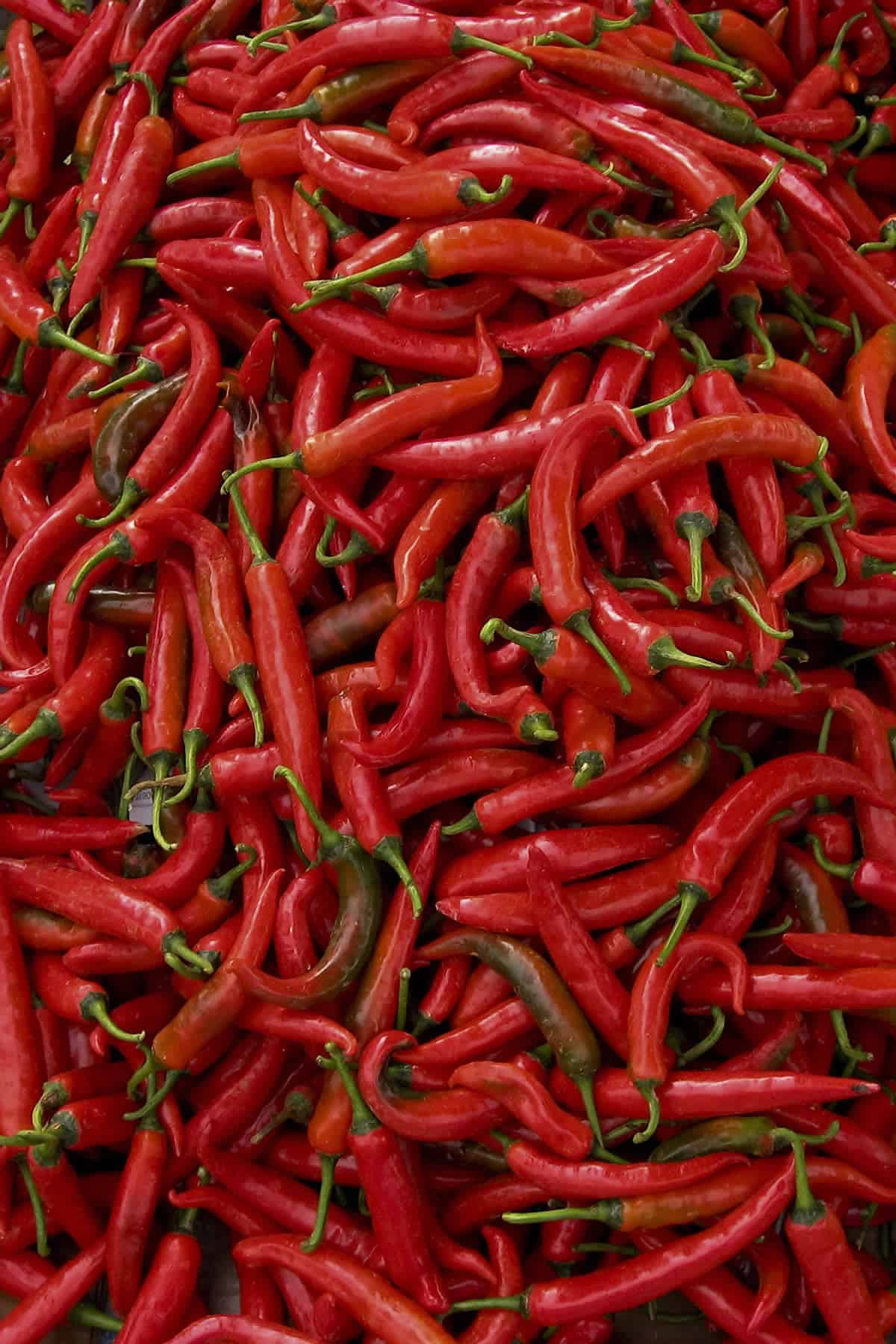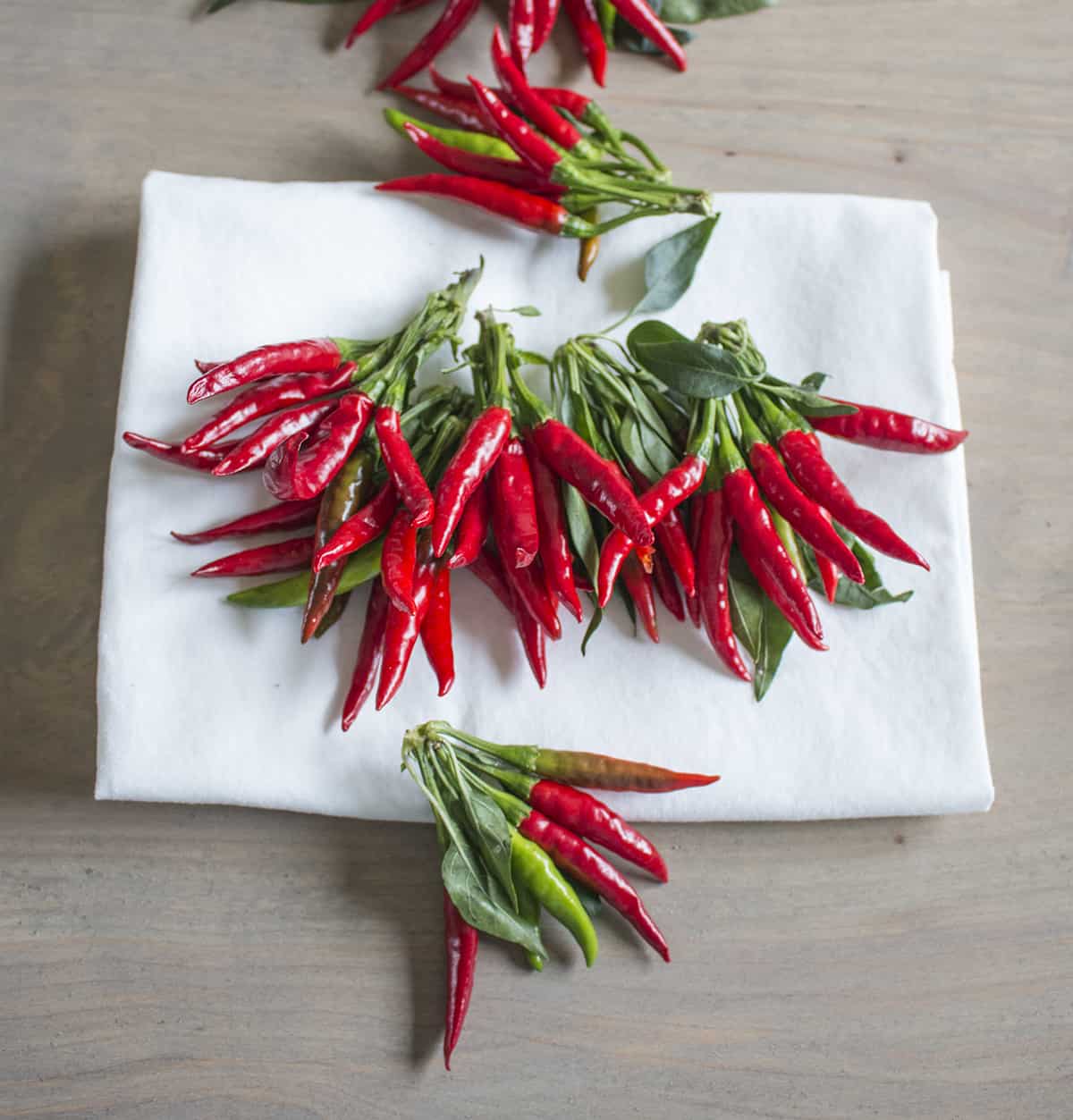Thai peppers are spicy chili peppers with a wide range of heat, and despite common belief, there is no single type of Thai pepper, with at least 79 separate varieties. Learn more about them, their heat ranges, how to cook with them, and more.

Scoville Heat Units: From 0 (very mild) to many in the range of 50,000 - 100,000 SHU
Capsicum Annuum
Despite what is commonly believed, there is no single "Thai pepper", though most peppers referred to as Thai are small in size and high in heat or pungency. There are at least 79 separate varieties of the pepper that have appeared from three species in Thailand, and they grow in green or red.
As with many other types of chili peppers, there is strong debate about them, and a particular confusion when it comes to Thai peppers.
Types of Thai Peppers
Prik num or "banana peppers," for example, resemble a New Mexican pepper, and they are also grown in Kashmir, India, and thus are also known as Kashmir peppers. It is further confusing as the Kashmir is ALSO known as the Sriracha, a name associated with the famous sauce originally made from these peppers in the Thai seaside town of the same name.
Others are called prik yuak (milder, sweet), prik chee fah (milder, green and red varieties), prik leuang (with milder heat, great for pickling), prik jinda (hot peppers), and prik kee noo (very hot, similar to bird's eye chilies).
Agriculturally speaking, we specify that two types of chili peppers grow for harvest in Thailand: the prik khee nu (or prik kee noo) or "bird pepper" and the prik khee fah or plain "chili pepper."
How Hot is a Thai Pepper?
Because of the wide variety, Thai peppers typically range from 50,000 to 100,000 Scoville Heat Units. Compare this to a typical jalapeno pepper, which ranges from 2,500 to 8,000 Scoville Heat Units, making the average Thai pepper about 15 times hotter than the average jalapeno.
The red bell pepper, by contrast, measures 0 Scoville Heat Units.
Cooking with Thai Peppers
Thai peppers are typically ground to add heat to curry pastes, and to add both spiciness and alluring color to Thai food. Discerning chefs and cooks love them for garnishing hot and spicy dishes, and cooking them into all manner of foods.
Thai peppers also appear in other Thai dishes and Asian cuisine including that of Myanmar, where they are known as "nga yut thee", often cooked into curries like spicy green curry, as well as in "balachuang", a common spicy relish.
Laotian cuisine incorporates similar peppers called "mak phet", which are used in pastes or stuffed and steamed to create spicy vegetable and fish dishes.
Cambodia and Vietnam have related peppers as well, featuring them in various chili pastes and sauces. They are often stir fried and essential to Thai cuisine, often added to fried rice and so many other dishes.
My Personal Experience
I have grown a few different varieties of Thai pepper in my own home garden and have had great success. They grow very easily and most plants are very productive.
These were grown in my garden. You can use other chili peppers as a substitute for Thai peppers, but I definitely encourage you to grow and cook with a variety.

They're outstanding for dehydrating and grinding into chili flakes or chili powders, and also for making hot sauce.
Try some of these recipes that love to include Thai peppers.
See also these Types of Thai Chili Peppers
About Mike
Mike is the author of "The Spicy Food Lovers' Cookbook" and "The Spicy Dehydrator Cookbook". He is a chili pepper enthusiast who has run Chili Pepper Madness for many years.
NOTE: This page was updated on 4/26/22 to include new photos and information. It was originally published on 10/3/13.



Arkelanor says
Absolutely delicious! Because of my personal taste, I added a small Thai pepper, a dash of extra salt and doubled the garlic and olive oil. I also had tasted a hint of orange in a gazpacho I ate at a Spanish restaurant and I had dried and ground orange rinds, so I added a teaspoon of that. Paired it with your suggestion of a medium boiled egg and a slice of sourdough bread, along with a glass of Pinot Grigio. The perfect summer dinner!
Mike H. says
I am really happy to hear that, Arkelanor. Glad you've customized it to your liking.
John Snow says
Plaza Singapura is a renowned shopping destination nestled in the heart of Singapore, offering a unique blend of retail therapy, entertainment, and gastronomic delights.
Ralph Telles says
While in Vietnam, Thai peppers were the best thing to make my meals even c-rations taste better. When the girls sell sodas in the field they always had Thai peppers. Couldn't find anything else to make me feel like my chili at home in New Mexico.
Leiridiane says
Hi! Came trough your website looking for thai peppers type. I'm desperate to know if in Thailand they have de pout pepper. Do you know?
So comom here in Brazil and very aromatic. I personally do not like spice peppers but the pout type has my heart.
Mike Hultquist says
Does it looks like the peppers on this page? https://www.chilipeppermadness.com/chili-pepper-types/roquito-peppers/
Lee says
Mike, the picture of the Thai peppers from your garden - what variety are they? Birds Eye? Dragon? Thai hot? I see so many different names being tossed around online, so I’m curious which one you have found to be most authentic and enjoyable. And perhaps a link to source seeds 😉
Mike Hultquist says
I've grown so many Thai types! Sorry, not sure which ones I grew that year. Check out my Seeds Resources in the Resources section for growers/sellers. I think all the varieties are great! I know I'm not very helpful here.
Darryl R Reddy says
I currently have a five foot tall by 4.5 feet wide Thai pepper plant.
I got the seeds from Thai peppers from grocery store. I know peppers well and they are for sure Thai of some type.
Is it normal for a Thai pepper plant to be that size in 8 months?
it has about 200 peppers on it currently. I have been unable to find any other examples of one as big as the one I'm growing.
it's indoor grown, I feed it a lot only because it is always hungry lol. I've never caused nutrient burn or lock or any other issues but it likes to be fed daily. it's extremely healthy.
anyway just curious if I have a mutant lol
Mike Hultquist says
That's amazing, Darryl. I've only heard of this from outside plants in very warm climates that can grow very large and are very productive. I'd love to hear what others have to say!
Darryl R Reddy says
I thought it was somewhat unusual. I can send pictures if there's a email address I can send too.
I'd love to share images of the plant, I've not seen any other Thai pepper plants like it
Mike Hultquist says
Yep, Contact Page is here: https://www.chilipeppermadness.com/general-content/contact-chili-pepper-madness/
Darryl R Reddy says
great, next nice day I'll take it outside to get a good picture, I'll also show the indoor set up.
thanks
Darryl R Reddy says
I'll get the pictures sent soon but I just tried a couple of the ripe peppers....Holy hell those are the absolute hottest Thai pepper I've ever eaten. I can handle habaneros without too much difficulty but these Thai peppers made me feel temporarily insane lol
Ed says
will thai chili cross with jalapeno, cayenne or chile de arbol?
Mike Hultquist says
Ed, I have not done this personally, but pepper varieties within the same species and even some from different ones can cross to create viable pods.
Watashi says
For fun, run prik kee noo through Google translate